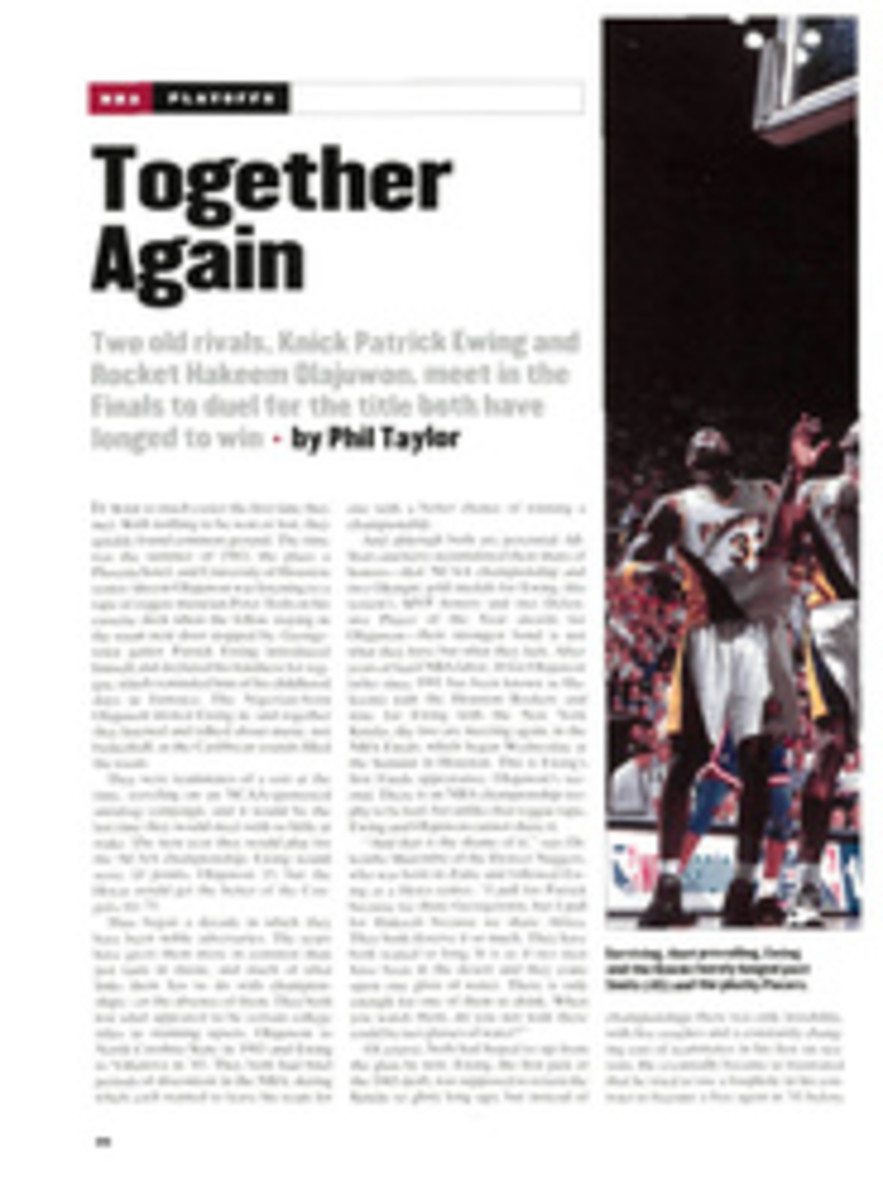
Now for an Oblique Daffy
If Dale Stuart weren't so addicted to jumping out of airplanes and performing gymnastic maneuvers while in free fall, she would be a classic egghead. If she weren't the reigning aerial freestyle world champion, she might be seen on The Discovery Channel rather than on ESPN. And if her performances had not caught the attention of movie and television producers, she might feel more comfortable in front of high-tech computer systems than high-powered Hollywood agents.
But Stuart, 35, is like no other world-champion athlete. She not only is as smart as a rocket scientist but also actually is a rocket scientist. She has a doctorate in aerospace engineering from MIT, she has helped design several NASA satellites, and she has won awards for her 351-page doctoral thesis, A Guidance Algorithm for Cooperative Tether-Mediated Orbital Rendezvous (in layman's terms, an examination of spaceship rendezvous techniques).
Stuart's skydiving has been featured on two 30-minute ESPN specials as well as on ABC, NBC and CNN. She is a member of the Screen Actors Guild and is represented by International Management Group, the same talent agency used by Wayne Gretzky, Joe Montana and Pete Sampras. Stuart was a stunt double for Nastassja Kinski in the film Terminal Velocity, due to be released later this summer. And she has never lost a competition in aerial freestyle skydiving.
Called simply freestyle by its devotees, the sport combines the flips and loops of gymnastics and the poses and pirouettes of figure skating, along with several moves unique to skydiving. These are all done while the diver hurtles to earth at speeds approaching 120 miles per hour. Skydiving is a vertical sport, like platform diving, only the platform is 12,500 feet high. A freestylist leaps from an airplane, performs a 50-second routine in free fall—taking advantage of what Stuart terms "three-dimensional freedom"—and then, at about 3,000 feet, opens a parachute and floats to the ground.
Freestylists do not leap alone. On each jump the diver is joined by a camera-person who has a video camera attached to the top of his or her helmet in order to film the jump. Judges on the ground, who see nothing but airborne specks during the performance, review the video and grade the freestylist on creativity, control and degree of difficulty. Then, in a twist unique to aerial freestyle, the judges also grade the camerawork. It counts for 35% to 50% of the final score, making freestyle not only a team effort but also the world's only video-dependent sport. Stuart's cameraman, 53-year-old Ray Cottingham, has filmed heron more than 1,500 jumps.
Aerial freestyle is less than 10 years old. Sky divers began fiddling with freestyle moves in the mid-1980s, and the first world championships were held in Texas in 1990. Stuart won the women's division—six teams competed—and she has won every year since then, despite rapid growth in both the number of participants and the level of competition. In the 1993 championships, held in Spain, a total of 40 teams from 15 countries participated; even more are expected for this year's competition, scheduled for early October in Eloy, Ariz.
One look at a video of Stuart's most recent world-championship performance, and you can easily understand freestyle's appeal among sky divers. Instead of remaining as flat and stable as possible, in the traditional belly-to-earth pose, Stuart—wearing a pink Lycra bodysuit and white ballet shoes—performs intricate moves with names like jackknife back loop, front layout double twist, prancer pirouette, compass leg roll, oblique daffy and Frisbee. Some moves are rapid, with Stuart somersaulting through space like a trapeze artist; others are slow and controlled, with Stuart practically floating downward, her arms and legs outstretched, like a leaf in the wind. All the moves are linked seamlessly in a routine that seems more like avant-garde dance than athletic competition.
"Dale has created real, novel beauty," says her husband, Dave, who tried skydiving four times before deciding to call it quits. (He is also an aerospace engineer; they met in MIT's Space Systems Lab.) Dale, who has invented hundreds of freestyle tricks and wrote the first book on aerial freestyle, which detailed 90 different moves, waxes poetic about her flights of fancy. "When I step out of a plane, I experience a feeling of total release," she says. "There is a magic to it, a mystical element. There are so many more moves possible in the sky than on the ground. The lack of any kind of hard surface opens up a whole new domain of athletic possibilities."
Stuart is tall, long-legged and astoundingly flexible. She can bend her body into positions other freestylists cannot, and her svelte figure belies her tremendous strength. Her smile is of game-show-host proportions, and her high-energy freestyle performances seem infused with genuine euphoria—all assets in a sport that is judged subjectively.
But most of all, Stuart is a world champion because of her mind. Though she did not try skydiving until her final year at MIT, when she was 27, her studies in aerodynamics and physics had given her an understanding of the physics of free fall. Stuart's learning curve was exceedingly short; she grasped quickly how to control her motions in the air and soon became a full-fledged "jump bum," camping out every weekend at a skydiving center in Maine.
In 1987 she moved to her current home in Torrance, Calif.—"skydiving paradise," Stuart calls it—and continued jumping, mostly doing group formations, such as snowflakes, stars and doughnuts, with four or five jumping buddies. Then she saw a movie that changed her life: a mid-'80s skydiving film called From Wings Came Flight, which showed some of the first footage of aerial freestyle. "When I saw that movie," says Stuart, "it was like discovering a new dimension. Instead of belly to earth, I saw people doing flips and loops and still remaining in total control. I thought of the moves I did as a high school gymnast, and I imagined myself doing them all in midair."
She soon realized how difficult these moves are to master. "Sky divers appear to be weightless," Stuart says. "But when you're in the air, there's a tremendous wind rushing over you. It feels like you're standing on the roof of a car going 120 miles per hour, but the wind resistance is what allows us to do all these moves." To perform while in free fall, Stuart makes subtle motions that manipulate the force of air against her body, rotating her one way or another. Freestyle takes a surprising amount of strength—Stuart compares it with a workout on the rings in gymnastics—and, at the same time, is extraordinarily precise. "If everything isn't perfectly aligned," says Stuart, "you'll fall right out of the move and start whirling around."
Stuart learned all the moves done in Wings and then began inventing her own techniques. She had been practicing freestyle for about a year when she spotted an announcement in a skydiving magazine for the first world aerial freestyle competition. She decided to enter. "I never do anything halfway," she says. "Once I made the decision to compete, I committed myself to it." Stuart embarked on a demanding training regime: "For each move, I studied and practiced until it was polished to perfection. I worked until there was not so much as a bobble." She won the competition and has yet to relinquish her title.
Stuart trains more than other women in the sport. She devotes one week a month and every weekend to practicing for the annual championships, freestyle's biggest event. She makes about 700 jumps a year. She quit her job as an aerospace engineer to allow more time for freestyle and is now setting up a company that specializes in computer graphics and animation. She recently bought a large camper in which she sleeps while at training sites, and she equipped it with a TV and VCR so that she can immediately review the footage of each of her jumps. "She is so committed to creating the best routine possible," says Cottingham, a chemical-process engineer who has also worked as an aerial cinematographer for films, "that I sometimes worry about our overtraining."
Stuart is as dedicated to safety as to flawless routines. She is so exacting when she packs her parachute that she has had to use her reserve chute only once in more than 3,000 jumps. Her worst skydiving injury was a bruised ankle. And her perfectionism is starting to pay dividends. While freestyle competition doesn't offer any cash prizes—"It's how I dispose of my disposable income," says Stuart—she has hopes of continuing to land well-paying skydiving stuntwork for television and movies. But fame and fortune, should they arrive, are not likely to soften Stuart.
"This may seem difficult to believe," she says, "but for this year's championships, I'm going to train even harder."
PHOTO
RAY COTTINGHAM
Stuart has 50 seconds in which to execute her moves, which may include a Cleopatra pose.
PHOTO
RICK RICKMAN
Dale and Dave met at MIT. Cameraman Cottingham (below, right) is essential to her act.
PHOTO
JAMIE PAUL
[See caption above.]

